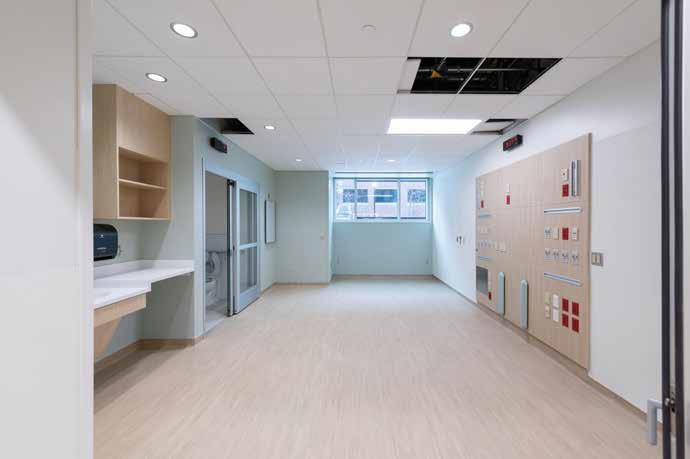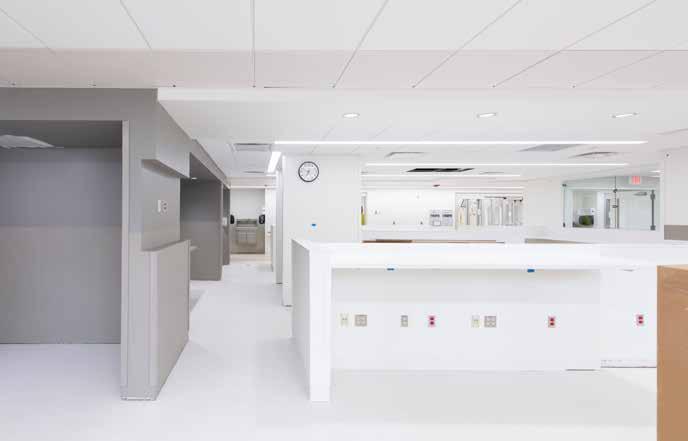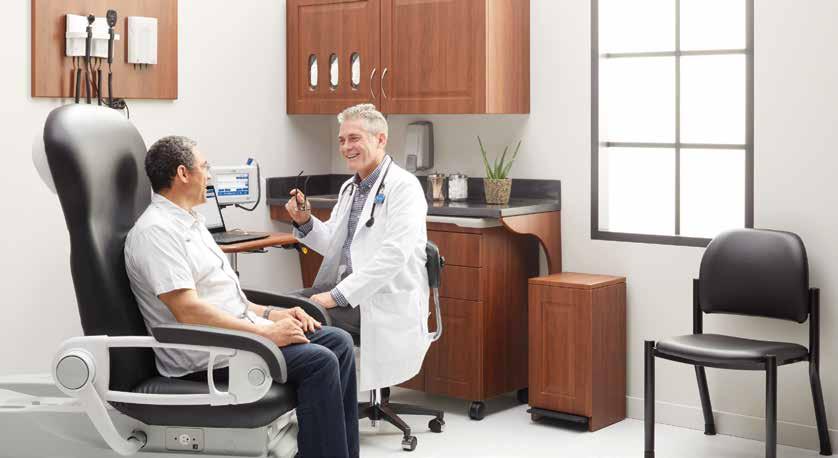World-Class Emergency Services
Supply chain has played an important part in the building of UC Health’s new emergency department. It will play an even bigger role when the facility opens this year.


Supply chain has played an important part in the building of UC Health’s new emergency department. It will play an even bigger role when the facility opens this year.


When the ultrasonic cleaner is supplying sufficient energy and condi�ons are correct, SonoCheck™ will change color. Problems such as insufficient energy, overloading, water level, improper temperature and degassing will increase the �me needed for the color change. In the case of major problems the SonoCheck™ will not change color at all.
Reveal the hidden areas of instruments with the TOSI® washer test, the easy to use blood soil device that directly correlates to the cleaning challenge of surgical instruments. TOSI® is the first device to provide a consistent, repeatable, and reliable method for evalua�ng the cleaning effec�veness of the automated instrument washer.
The LumCheck™ is designed as an independent check on the cleaning performance of pulse-flow lumen washers. Embedded on the stainless steel plate is a specially formulated blood soil which includes the toughest components of blood to clean.

This kit simulates a flexible endoscope channel to challenge the cleaning efficiency of endoscope washers with channel irriga�on apparatus. A clear flexible tube is a�ached to a lumen device with a test coupon placed inside; the en�re device is hooked up to the irriga�on port of the endoscope washer.
Go beyond what you can see with all-in-one detec�on kits for blood or protein residue. HemoCheck™ is simple to interpret and indicates blood residue down to 0.1μg. The ProChek-II™ measures for residual protein on surfaces down to 0.1μg.



2 ‘Advanced Practice’ or ‘Scope Creep?’ Disagreement about the role of nurse practitioners and physician assistants.
10
Supply chain has played an important part in the building of UC Health’s new emergency department. It will play an even bigger role when the facility opens this year.

18 2023: Time for Solutions
Last year brought its share of challenges. Finding solutions is the hard work awaiting everyone in the healthcare community this year.
24 SMI
Five Healthcare Supply Chain Priorities for 2023
PUBLISHER
John Pritchard jpritchard@sharemovingmedia.com
DIRECTOR OF BUSINESS DEVELOPMENT
Anna McCormick amccormick@sharemovingmedia.com
EDITOR Graham Garrison ggarrison@sharemovingmedia.com
SENIOR EDITOR
Daniel Beaird dbeaird@sharemovingmedia.com
ART DIRECTOR Brent Cashman bcashman@sharemovingmedia.com
CIRCULATION
Laura Gantert lgantert@sharemovingmedia.com
Disagreement about the role of nurse practitioners and physician assistants.
Physician assistants are healthcare professionals licensed or credentialed to practice medicine with physician supervision. Today, there are more than 159,000 PAs practicing in every state and medical specialty. Advanced practice registered nurses (APRNs), on the other hand, include nurse practitioners, clinical nurse specialists, nurse anesthetists and nurse midwives, according to the American Nurses Association. Today, more than 200,000 APRNs are treating Medicare patients, and approximately 40% of Medicare beneficiaries receive care from APRNs.
The roles these providers will assume in healthcare could become more important as the U.S. grapples with current and future shortages of healthcare workers.

Do you refer to nurse practitioners and physician assistants as “advanced practice providers,” or as “nonphysician providers”? Both labels are correct, but each represents a different perspective on how – and by whom – healthcare should be delivered. One emphasizes the services these professionals can potentially provide, while the other hints at what they cannot or should not do.
National data shows there will be a shortage of up to 3.2 million healthcare workers by 2026, says Jennifer Orozco, president and chair of the American Academy of Physician Associates. Today more than 99 million Americans lack adequate access to primary care and more than 158 million lack adequate access to mental health care, she says. Projections show almost 81 million people will be over the age of 65 by 2040. On top of this is a continuing rise in obesity and chronic diseases such as diabetes and heart disease.
Orozco believes physician assistants are essential to ensure patients have access to
As a leader in smart infusion therapy and safe and effective pharmacy products, we’re committed to helping providers improve patient satisfaction and outcomes. With infusion pumps, accessories and services created to help you focus on what matters most—your patients—we’re uniquely positioned to help your facility succeed now and in the future. Because at B. Braun, providers are our purpose.
www.bbraunusa.com/infusionsystems

the care they deserve. “Physician assistants are defined by their commitment to putting their patients first and applying their medical expertise, comprehensive diagnostic skills, and compassion to improving the health of their patients and communities,” she says. “They know that quality care starts with a human connection, which is why we are drawn to the profession.”
Whether physician assistants or advanced practice registered nurses (APRNs) assume greater responsibilities in the exam room remains a question. Advocates believe they should be allowed to practice to the full extent of their educational and professional experience – and hence assume greater responsibilities. But others pejoratively call that “scope creep.”
“The PA profession’s commitment to team practice is powerful,” she continues. “The PA and physician who work together keep all the benefits of the team without the legal risks and administrative burdens that agreements entail.”
In its 2021 report “The Future of Nursing 2020-2030,” the National Academy of Medicine voiced its support for greater roles for APRNs, writing, “Expanding scope of practice for advanced practice registered nurses, including nurse practitioners – which allows them to prescribe medication, diagnose patients and provide treatment independent of a physician – would significantly increase access to care, particularly in rural and underserved communities, which tend to experience high poverty rates and a heavy burden of chronic disease.”
voiced concern over expanding roles for APRNs and PAs.
In a report adopted in 2022, the AMA said the core issue is that “the skill sets and experience of nonphysician practitioners are not the same as those of physicians.” AMA added that when nonphysician practitioners identify themselves as “doctors,” consistent with the doctorallevel degrees they earned, it may create confusion and be misleading to patients and other practitioners. (The AMA was referring to nonphysician practitioners who have received advanced training resulting in a doctorate degree, such as a doctor of nursing.)
AMA argues that:
` Nonphysician care can cost more than that provided by an M.D. (Research shows that in states that allow independent prescribing, NPs and PAs were 20 times more likely to overprescribe opioids than those in prescription-restricted states, according to AMA. Moreover, X-ray ordering rose by more than 400% by nonphysicians, primarily NPs and PAs, between 2003 and 2015.)
“Outdated laws limit flexibility, generate unnecessary paperwork and burdensome administrative constraints, and prevent providers from going to areas where a physician may not be practicing,” says Orozco. “In order to meet growing healthcare needs, these outdated laws must be updated to reflect how medicine is delivered in 2022. Many states removed these outdated barriers during the pandemic, which is how we were able to take care of so many. Now is the time to remove them permanently.
Even some payers have weighed in. According to a 2018 UnitedHealth Group report, if all states were to allow nurse practitioners to practice to the full extent of their education and training, about 31 million more people living in primary care shortage areas would have access to the primary care they need to stay healthy.
But not everyone agrees. As of early 2021, 27 states restricted full practice authority for nurse practitioners, according to the National Academy. Furthermore, major physicians’ associations – including the American Medical Association – have
` Access to care is not improved by employing more NPs and PAs. (In reviewing the practice locations of primary care physicians compared to NPs, physicians and non-physicians tend to practice in the same areas of the state, according to AMA. This is true even in those states where, for example, NPs can practice without physician involvement.)
` Surveys show that most patients believe a physician’s years of education and training are vital to optimal patient care, especially in the event of a complication or medical emergency.
‘During these challenging times, it is more important than ever to ensure all healthcare providers are allowed to practice to the full extent of their education and training.’
Welch Allyn Spot Vital Signs


MONITOR
THE PROBLEM IS CLEAR: MANUAL, IN-OFFICE READINGS ARE NOT SUFFICIENT TO PROPERLY IDENTIFY HYPERTENSION.1
The Welch Allyn Spot Vital Signs 4400 offers data you can trust with one tap blood pressure averaging for simple and accurate vitals management. Learn how you can save more than $1,000/ year in time2 by switching to automated vitals at hillrom.com/hypertension.

References
1. Handler J, Zhao U, Egan BM. Impact of the number of blood pressure measurements on blood pressure classification in US adults: NHANES 1999-2008. J Clin Hypertens 2012; 14 (11): 751-759.
2. Yarows SA. What is the Cost of Measuring a Blood Pressure? Ann Clin Hypertens. 2018; 2: 059-066. https://doi.org/10.29328/ journal.ach.1001012
Hillrom.com
Growth in responsibilities for advanced practice registered nurses will come when “healthcare consumers demand access to high-quality care and the realization that APRNs are limited in their ability to practice to the full extent of their education and clinical training due to old and outdated barriers posed by some federal statutes and regulations, state practice acts, and institutional rules,” says Sean DeGarmo, PhD, RN, ACNS-BC, FNPBC, ENP-BC, director, American Nurses Credentialing Center, Advanced Practice Initiatives and Certification Outreach.
Growth in APRNs’ responsibilities has already occurred, says Phyllis Whitehead, PhD, CNS/APRN, ACHPN, PMGT-BC, FNAP, FAAN, president of the National Association of Clinical Nurse Specialists. Key areas with growing responsibility for CNSs include prescriptive and full practice authority. A recent update showed that 24 states allow independent prescribing for the CNS and an additional 15 allow prescribing with a collaborative practice agreement with a physician.
“The expansion of the CNS’s role in primary care, home care and hospice, community and public health particularly under the Obama administration created new opportunities for CNSs,” she says. “The timing was right, as when the pandemic hit, CNSs were already working across hospitals, systems, in homes and the community.”
Advanced practice registered nurses are optimistic that the “Improving Care and Access to Nurses (ICAN) Act,” introduced in the House of Representatives in September 2022, will help advance the scope-of-issue cause. “The ICAN Act would ensure that certified nurse-
midwives and other APRNs are able to provide comprehensive, coordinated, high-value care to the people and families they serve,” the American College of Nurse-Midwives said in a press release. If passed, the law would:
` Authorize certified nurse-midwives (CNMs) to bill for services related to training medical interns and residents in obstetrics in teaching facilities.
` Enable CNMs to be included alongside nurse practitioners and physician assistants as providers eligible to certify and recertify a Medicare beneficiary for home health services without being subject to physician supervision.

` Enable CNMs to issue a prescription or written order for durable medical equipment, prosthetics, orthotics and supplies (DMEPOS) to Medicare beneficiaries as well as provide face-toface encounters without being subject to physician supervision.
"Modern healthcare requires flexibility,” said ANA President Ernest Grant, PhD, RN, FAAN, when ICAN was introduced. “We cannot not be hindered by antiquated barriers to practice or petty turf wars over perceived hierarchies. The health of our patients and communities must come first.”
‘We cannot not be hindered by antiquated barriers to practice or petty turf wars over perceived hierarchies.’
revolutionized personal hand protection forever with the invention of the world’s first nitrile exam glove.
Since that time, the integrated manufacturer has accomplished a “Legacy of Firsts” for health care providers:
SUPPLY CHAIN ASSURANCE. CHAIN OF CUSTODY. BORN AND BRED IN THE .
2022
Stood up two more high speed monorail lines now with 800M glove capacity annually
1990
Invented of the world’s first nitrile exam glove
First 510(k) for the world’s first nitrile exam glove
Patent for nitrile exam held for over a decade
Research, development, and production of nitrile exam gloves in the USA since 1990
1990
1995
2000
Inventor of the world’s first nitrile accelerator-free exam glove (low dermatitis potential)
2012
Invented ECO BEST TECHNOLOGY ®
Launched the world’s first biodegradable nitrile exam glove
2010
Additional 40,000 square foot expansion in 2022
2021
Stood up two high speed monorail lines adding 400M glove capacity annually
29 Chemotherapy Claims and Fentanyl Tested
2020
510(k) for the Fayette, AL production facility
2020
2004
Inventor of the world’s black nitrile elocstratic discharge glove
2018
Expanded Eco Best Technology ® in all exam gloves

2019
40,000 square foot expansion in Fayette, AL
Let SHOWA be part of your Supply Chain Assurance solution for Nitrile Exam Gloves. SHOWA has manufactured nitrile exam gloves in the U S A since 1990!
Physician assistants are healthcare professionals licensed or credentialed to practice medicine with physician supervision. According to the American Academy of Physician Assistants, they generally can:
` Take medical histories
` Conduct physical exams
` Diagnose and treat illness
` Order and interpret tests
` Develop treatment plans
` Prescribe medication
` Counsel on preventive care
` Perform procedures
` Assist in surgery
` Make rounds in hospitals and nursing homes
` Do clinical research
` Counsel on preventive care
Despite the current healthcare workforce shortage, the PA profession continues to grow, says Jennifer Orozco, president and chair of the AAPA, noting that the Bureau of Labor Statistics estimates the profession will grow 28% between 2021 and 2031. “PAs account for more than 500 million patient visits each year – a number that will continue to grow as we push to modernize healthcare teams and use every team member to the fullest extent of their education and training,” she says.
In 2021, the AAPA passed a policy affirming “physician associate” as the official title for the PA profession. (The title will be phased in over time.) “The new title directly addresses the common misperception that PAs merely ‘assist’ physicians, when in reality, they do so much more,” she says.
Advanced practice registered nurses hold at least a master’s degree in addition to the initial nursing education and licensing required for all registered nurses (RNs). They include nurse practitioners, clinical nurse specialists, nurse anesthetists and nurse midwives.
Nurse practitioners (NPs) take health histories and provide complete physical examinations; diagnose and treat
common acute and chronic problems; interpret laboratory results and imaging studies; prescribe and manage medications and other therapies; provide health teaching and supportive counseling; and refer patients to other health professionals as needed. An NP’s practice may also include education, research, and administrative services. Specialty areas include:
` Acute care
` Adult health
` Family health
` Gerontology
` Neonatal health
` Oncology
` Pediatric/child health
` Psychiatric/mental health
` Women’s health
Clinical nurse specialists are advanced practice registered nurses who have graduate preparation (a master’s or doctorate) in nursing, according to the National Association of Clinical Nurse Specialists. In the majority of states, clinical nurse specialists must obtain certification based on a population area. Current certification examinations based on population include:
` Adult/gerontology
` Pediatrics
` Neonatal
“CNSs are unique and one of the most versatile APRNs,” says Phyllis Whitehead, PhD, CNS/APRN, ACHPN, PMGT-BC, FNAP, FAAN, president of the National Association of Clinical Nurse Specialists. “They can work at hospital/health systems, medical practices, long-term care facilities, retail clinics, and home care.” The top 10 hospitals in the country employ CNSs, she says, and 62% of CNSs work in hospitals that are either accredited by the American Nurses Credential Center Magnet™ Recognition Program or are seeking accreditation.
According to Recruiter.com, CNS job growth has reached 13% annually, says Dr. Whitehead. “Over 332,000 CNS positions will need to be filled by 2029. The NACNS Job Board routinely has between 300-400 jobs available.”







Supply chain has played an important part in the building of UC Health’s new emergency department. It will play an even bigger role when the facility opens this year.
BY GRAHAM GARRISONEmergency services are a big part of UC Health’s legacy. The UC Department of Emergency Medicine is home to the first residency training program in the U.S., and the program celebrated its 50th anniversary in 2020. The department attracts top medical students from across the country to train in Cincinnati, and its faculty are national leaders in clinical teaching and research.
When UC Health got the greenlight to build a new facility for its emergency department from the ground up, leadership wanted the physical building to match their top tier ranking from a clinical perspective. To do that, they needed supply chain to play a key role.

The project was announced in October 2019. Ground was broken on the structures in late summer 2021, and completion is expected in late summer 2023, according to the IDN. The project includes:
` Expand the UC Medical Center Emergency Department (ED) onto a previously vacant lot adjacent to the hospital. The 41,000-square-foot addition will significantly improve capacity and patient flow, including reconfigured access for patient arrivals via ambulance and private vehicles.
` Renovate the existing 35,000-square-foot ED to provide additional emergency response ability and “surge” capacity for emergency and crisis situations.
` New construction of three additional floors above the new emergency department to accommodate an observation unit, a flexible ICU and a new 28-bed unit.
` New construction of a four-story surgical building that will expand surgical capacity at the hospital, adding eight new operating rooms as well as new waiting areas and pre-operative clinics.
During the design phase, UC Health leadership that included supply chain and clinicians took a few trips across the country to look at best-in-class emergency department set ups, including Mayo Clinic, to determine how they wanted to design their facility.

From a supply chain perspective, it was beneficial to be included early in the process, said Harold Dillow, assistant vice president of supply chain for UC Health. He has spent a lot of time with the emergency management service line people that represent College of Medicine, emergency management physicians, and then with UC Health’s own nursing administration that runs the ED to better understand what their expectations are for a best-in-class ED, and how the supply chain would service them. There are monthly meetings between supply chain, ED leadership that includes nursing and College of Medicine representatives, and a consultancy agency
quarterbacking the process to talk about the progress of the project.
From theoretical to actual UC Health’s current service model involves stocking a supply room in a couple of areas in the ED. Clinicians, nurses or technicians retrieve the supplies on their own. In the new ED, clinicians would like supply chain to provide everything they need at the point-of-use of where the care is being delivered, so the clinical person never has to leave patient care area or the “bedside”. It takes resources, more staff members and a new supply stocking strategy that UC Health’s team has been developing to be ready to roll out when the new ED is scheduled to open in July 2023. “It is fundamentally different than how we do it now,” Dillow said. “Now they retrieve supplies as opposed to us putting it at their fingertips.”
UC Health is developing an exchange cart process for the new ED. The concept is to always have supplies as close to full for the clinical team. Every single ED bay will have a cart stocked according to what the clinicians think would be the most used products at appropriate par levels. To stock the carts for the entire ED, supply chain will be allocated a large supply room in the middle of the space. The new ED is roughly the same number of rooms, but double the footprint.
“We have a lot of input on the design of the supply room because we want it to be big enough to not only have our inventory system hanging on the wall, but also space in the middle for the exchange carts to be restocked,” Dillow said. “We can take a full exchange cart, go to a room and grab one that’s been used and put the full one in. Theoretically there’s always plenty of supplies in every single room.”
Some parts of the process are already in place. For instance, last April, UC Health implemented a new point-ofuse inventory management system that tracks supplies better and reorders with RFID technology. It’s a much more efficient way of reordering supplies, Dillow said. “So, setting up a best-inclass process and then layering on some technology we think is going to be a really awesome combination.”
Supply chain is working on a myriad of small details for the new ED, such as the routes they would use to stock rooms, and when they would do it, so they’re more offstage from the public. They’ve worked on where the carts are going to be staged in the rooms, and will eventually focus on the individual items the clinicians want in the carts.
“We’ve even gotten it down to what color handles should be on the carts, and the visual cue to let everyone know that a cart’s been used,” Dillow said. “Those are the granular types of decisions we’re figuring out so it can flow as smoothly as possible.”
Dillow said he’s excited to see the efficiencies gained from the new model. The estimated increased bedtime for clinicians alone was high enough to get a healthy FTE approval to build up the supply chain team in the ED for 24/7 across three shifts. “The goal is to have everybody practicing at the top of their license,” he said. “The nurses and physicians can be honed in on what they’re doing to help the patient as opposed to worrying about grabbing supplies. There’s
going to be huge intangible cost savings, but more importantly real savings for the patient care time.”
The supply chain team has been quite busy over the last 12 months, and not just on the new ED rollout. Recent accomplishments include:
` Managed through the highest surge of pandemic and ongoing global supply disruptions while supporting clinical operations.
“Many in the industry experienced this the past few years, but it is worth recognizing our supply chain team’s extraordinary effort to deliver quality products in a timely manner with the
odds stacked against them,” Dillow said. “While many items were procured via alternate sources or had to be converted, which resulted in clinicians having to use non-preferred product, we had great partnerships with the clinical team.”
` Reduced capital investment for instrument purchases to support the new surgical building. Supply chain and UC Health’s Perioperative Leadership Team partnered to calculate current instrument utilization and compare that to expanded case volumes to ensure only needed items were purchased.
` Simultaneously implemented two technology systems. UC Health chose to perform an ERP conversion and MMIS/ WMS conversion at the same time.

“I will say it was very difficult to implement two systems concurrently, but the team put forth an exhaustive effort to accomplish this goal,” Dillow said. “These new platforms enable us to gain efficiencies from automating processes that have traditionally been manual work. We intentionally refined and documented our manual processes so that we could layer on technology that would take us forward and not just be an expensive program built on inefficient, legacy processes.”
` Completed a GPO RFP. This was a large initiative that required strategic alignment across several departments (Finance, Supply Chain, Pharmacy) and included clinical partners.
“The result was UC Health selecting a GPO partner that most closely

understood our needs as a health system that includes an AMC and community-based acute care hospitals and large ambulatory footprint. This will deliver the highest quality contracts and products, and largest savings opportunities for UC Health.”
Another major achievement was managing through an extreme staffing crisis in Sterile Processing Department (SPD) where a large portion of the staff was recruited away for agency staffing companies. This directly impacted SPD’s ability to meet instrument tray demand for OR cases, Dillow said.
As a result, the SPD tray backlog, which is an indicator of SPD’s throughput and ability to provide on-time service, soared from a historical average of 50 trays to approximately 500 trays. Supply chain and PLT met multiple times per week for several months to jointly address the issue. A shared staffing model was implemented as an interim countermeasure as well as OR capacity management to ensure all scheduled cases were cared for. These interventions, combined with a coordinated recruiting effort with HR, resulted in the tray backlog returning to under 50.
“Over the last five to six years, supply chain has aligned and clinically integrated with our physician partners across all service lines,” said Dillow.
He said the springboard for this elevated engagement and alignment occurred because of their participation and involvement with the value analysis program and department specific product / implant standardization and savings initiatives related to:
` Ortho Trauma implants.
` Cardiology – CRM / DES.
` Ortho Total Joints
` ENT – Cochlear implants.
` Cardiovascular – Heart valves.
` Radiology – Peripheral vascular products.
` Ortho / Neuro spine implants.
Building trust through transparency and partnership with aligning clinical quality needs and outcomes with cost efficiencies has been one key to success. No silo product
decisions or changes without alignment of providers has been another key. Supply chain has also partnered with the chief medical officer to appoint a medical director for supply chain. “This has really helped navigate conversations with physicians and gain buy-in for service line product strategy.”
Heading into 2023, supply disruptions and staffing availability remain challenges to address. “The pandemic largely focused on PPE items,” Dillow said. “Once those were secured, it was really about operationalizing the stocking strategy needed to support COVID care.”
But since then, global supply disruptions are affecting a much broader portfolio
of products. “There’s almost no category that isn’t affected. Who would’ve thought crutches, of all things, would ever be an issue? That’s just one example of many.”
Because of this, UC Health’s sourcing and procurement teams have experienced a 900% increase in backorders.
“The constant management of alternate sourcing and related logistics is very time consuming, and quite frankly, frustrating for the team.”
Once you get the product, there is the additional worry of appropriate staffing levels needed to manage the inventory. In the case of SPD, its staffing needed to build case carts to support the OR.
It’s hard to reflect on the last few years and not think about battle scars, Dillow said. However, the challenges

presented during the pandemic and staffing crisis have silver linings. “We had to quickly adapt during those times to survive, and the key to surviving resulted in doing things differently.”
Although UC Health continually stress tests its processes to find improvement, those test scenarios simply didn’t include a once-in-a-century pandemic or having such a staffing deficit. So they adopted innovative ideas from their teams to create better processes and standardized those efforts where they made sense to carry on. “As a result, we have a better understanding of our end-to-end operations with process maps created because of the need to increase the speed of communication amongst supply chain teams, suppliers, and clinicians.”
UC Health also consolidated many reports and data sources that different
supply chain leaders were using to manage the business. Now there is one source of truth that pulls together inventory levels, sourcing notes, and procurement information to make educated decisions

UC Health’s sterile processing department (which reports to supply chain) has consistently averaged less than one patient safety issue per month reported in its clinical quality database. “This is an enormous achievement considering the average was 160 issues/month in 2017. This continues to be the most important initiative we focus on and measure.”
Since 2016, UC Health’s supply chain has delivered an ROI of 8:1 when comparing achieved savings versus team investment. “In a world of financial uncertainty, supply chain is uniquely positioned to be one of very few departments that can deliver that type of value to the organization,” Dillow said. “There is a tremendous amount of work and cross-team collaboration within supply chain and with clinical partners
based on a complete picture. “Lastly, we now have increased automation and data visibility that helps us be more proactive decision makers instead of always reacting and firefighting,” Dillow said.
to develop strategy and execute projects that deliver these savings. I am extremely proud we continue to deliver yearover-year results to UC Health.”
One of the UC Health system-wide strategic pillars is “Community Commitment.” Embedded within that pillar is a goal to improve the economic vitality of local businesses, Dillow said. To achieve this goal, UC Health has an objective to increase women- and minority-owned enterprise spend to 6% by 2025, which is a 1% increase over the current goal. “To meet this goal, we have a well-developed Diversity program within supply chain that leads to engagement with community partners. Not only do we routinely host a forum open to the public that connects diverse vendors with UC Health leaders, but we also invest time in diverse supplier development.”
While each patient journey is unique, medical diagnostics plays a crucial role in delivering data and actionable insights. At QuidelOrtho, we pride ourselves in providing these critical answers early and often in the healthcare continuum.
See what’s new at QuidelOrtho.com

Last year brought its share of challenges. Finding solutions is the hard work awaiting everyone in the healthcare community this year.
Editor’s note: The following is the second part of a two-part series.
2022 presented all kinds of challenges for providers, patients and public health professionals. No doubt many of those challenges will linger in 2023, and new ones will arise. However, researchers, providers, public health professionals, lawmakers – and supply chain leaders – can be expected to keep working through the tough issues facing them. This article will examine:
` Remote patient monitoring

` Climate change
` Opioids
Remote patient monitoring (RPM) continued to grow in 2022, largely because of technology advances and the preferences of patients, doctors and payers. The market for RPM was expected to reach $6.42 billion by 2030, an 18.64% compound annual growth rate during the forecast period 2022-2030, according to market research firm Market Research Future® . But the work of weighing costs against potential health benefits was expected to continue in 2023 and beyond.
COVID-19 boosted demand for remote patient monitoring services, as patients found it difficult to attend healthcare facilities and undergo hands-on medical evaluations, according to Market Research Future. The pandemic experience prompted investment in cutting-edge technological solutions to assist with managing medications, tracking disease symptoms and remotely monitoring vital signs. Expect demand to increase globally in the upcoming years, the firm said.
Another factor leading to growth in remote monitoring is the expected increase in the number of people with chronic conditions, predicted Forrester. A quarter of U.S. adults will be monitored remotely for chronic conditions. Weight scales, pulse oximeters, blood glucose meters, blood pressure monitors, heart monitors, and wearables were expected to improve clinical prognosis and help patients overcome socioeconomic hurdles, such as lack of transportation.
But remote patient monitoring comes with its own set of glitches, including the potential for data breaches and worries
about data privacy. And then there’s the difficulty of integrating patient-generated health data into the physician office EMR.
At its 2022 Annual Symposium, the American Medical Informatics Association reported the results of an EHR vendor survey dealing with the challenges of integrating patient-generated health data (PGHD) – such as that gathered via remote patient monitoring – with the EHR. Factors contributing to the difficulty of making such data actionable included:
` Lack of regulations and industry standards. Disparities exist among EHRs, devices and applications, according to survey respondents.
` Patient technology hurdles. Technical and data literacy must be considered for the target population. Do they have access to broadband Internet? Are they proficient in using monitoring devices (which can be challenging for those with multiple devices, or those with multiple chronic illnesses and who are often older)?
` Manual data entry and lack of analytics. Automated data entry is preferred.
` Lack of care delivery models. Responsibility for the data is needed and it needs to be tied to health outcomes to select the most appropriate data type and device to create value, said survey respondents. But national standards around care models for patientgenerated health data are lacking.
Challenges aside, the EHR survey respondents listed factors that can contribute
to the success of remote monitoring. They included:
` Organizational support and readiness, i.e., consistent processes on how to leverage PGHD and gain buy-in across the enterprise.
` Clinical champions to advocate and champion the use of remote monitoring.
` Targeted delivery model. PGHD needs to be tied to a clinical focus (e.g., congestive heart failure or hypertension), so that data and devices can be selected that are appropriate for specific clinical outcomes.
` Data governance. Protocols and triggers need to be incorporated into the EHR to encourage patient selfmanagement and clinician decision making. In addition, analytics are needed to eliminate “noise” in the data collected, and decisions need to be made as to how data will be analyzed over time.
` Interoperability. Data needs to be exchanged seamlessly among separate organizations, systems and sources.
` Technical support, particularly support for patients. Support ought to be provided by a technical person from the clinic or organization, the device manufacturer, or outsourced. (Clinical staff, such as RNs, are not the best fit for this role.)
` Economic viability. The use of PGHD needs to be incorporated into the business model of the organization to demonstrate revenue generation or cost-savings.
Hurricanes, floods, wildfires and extreme heat caught the world’s attention in 2022 and will most likely do so in 2023. But amidst the gloomy forecast lay a bright spot: By the end of 2022, the healthcare community appeared to be embracing its role in helping address climate change.
According to the World Health Organization, climate change threatens the essential ingredients of good health – clean air, safe drinking water, nutritious food supply and safe shelter. Between 2030 and 2050, it is expected to cause approximately 250,000 additional deaths per year from malnutrition, malaria, diarrhea and heat stress. Areas with weak health infrastructure – mostly in developing countries – will be the least able to cope without assistance.
In the weeks leading up to this past November’s climate talks in Egypt at the 27th Conference of the Parties of the UNFCCC (COP27), WHO made a strong case that health should be front and center during the climate change negotiations.
“Our health depends on the health of the ecosystems that surround us, and these ecosystems are now under threat from deforestation, agriculture and other changes in land use and rapid urban development,” said Dr Tedros Adhanom Ghebreyesus, WHO Director-General. The direct damage costs to health (i.e., excluding costs in agriculture and water and sanitation), is estimated to be between US $2–4 billion per year by 2030.
The combination of these factors means the impact on human health is likely to accelerate. “But there is room for hope, particularly if governments
take action now to honour the pledges made at Glasgow in November 2021 and to go further in resolving the climate crisis,” he said.
Closer to home, in June, the American Medical Association adopted a policy declaring climate change a public health crisis. The policy called for AMA to advocate for limits on global warming to no more than 1.5 degrees Celsius, reduction of U.S. greenhouse gas emissions aimed at carbon neutrality by 2050, and support of rapid implementation and incentivization of clean energy solutions and significant investments in climate resilience through a climate justice lens.
Three months after AMA‘s announcement, the American College of Physicians – which represents 160,000 members – released a position paper on environmental health. “The quality of the

environment can contribute to common diseases, such as stroke, heart disease, asthma and cancer,” ACP wrote in its paper. “Interventions such as reducing air pollution and water contamination, providing protection from ultraviolet radiation, and mitigating climate change can improve health outcomes for persons with communicable and noncommunicable diseases.”
In June, 61 of the largest U.S. hospital and health sector companies responded to the Biden Administration’s Health Sector Climate Pledge, committing to reduce greenhouse gas emissions 50% by 2030. That’s a positive step, as the healthcare sector accounts for 8.5% of U.S. emissions, according to The White House. The commitments represent over 650 hospitals and thousands of other providers across the country.
The healthcare community is embracing its role in helping address climate change.







Opioid addiction remains a painful part of life today and no doubt will remain so in 2023. Healthcare professionals have learned much about the problem and have reduced prescriptions for legal pain medications. In fact, over the past 10 years, opioid prescribing has been reduced in every state – and nearly 50% nationally, according to the American Medical Association. But their efforts will be challenged by manufacturers and distributors of illegal synthetic opioids, especially fentanyl.
More than 932,000 people have died since 1999 from a drug overdose, reports the CDC. In 2020, 91,799 drug overdose deaths occurred in the United States, 75% of which involved an opioid. Provisional data from CDC’s National Center for Health Statistics indicated there were an estimated 107,622 drug overdose deaths in the United States during 2021.

In November, the CDC released updated and expanded recommendations for clinicians regarding pain care.
The 2022 Clinical Practice Guideline addresses the following areas: 1) determining whether to initiate opioids for pain, 2) selecting opioids and determining opioid dosages, 3) deciding duration of initial opioid prescription and conducting follow-up, and 4) assessing risk and addressing potential harms of opioid use.
“We’ve been able to improve and expand our recommendations by incorporating new data with a better understanding of people’s lived experiences and the challenges they face when managing pain and pain care,” Debbie Dowell, MD, MPH, chief clinical research officer for CDC’s Division of Overdose Prevention, said in a statement.
Despite these positive efforts, however, drug-related overdose and death continue to increase, primarily due to illicitly manufactured fentanyl and fentanyl analogs, according to the AMA. In response to the fentanyl threat, the federal government in April 2021 made federal funding available for purchase of rapid fentanyl test strips. The strips can be used to determine if drugs have been mixed or cut with fentanyl, providing people who use drugs and communities important information about fentanyl in the illicit drug supply so they can take steps to reduce the risk of overdose.
Despite the efforts of providers, lawmakers and communities, the fight against fentanyl will no doubt continue to be fierce in 2023.
Healthcare professionals have learned much about opioid use disorder. But their efforts will be challenged by manufacturers and distributors of illegal synthetic opioids, especially fentanyl.
In this post-pandemic world, uncertainty is the new normal. Being resilient and ever-ready have moved from aspirational to table stakes. And now — more than ever — you need a reliable partner to support you and your patients every step of the way. That’s why we’re redefining supply chain expectations.
In this post-pandemic world, uncertainty is the new normal. Being resilient and ever-ready have moved from aspirational to table stakes. And now — more than ever — you need a reliable partner to support you and your patients every step of the way. That’s why we’re redefining supply chain expectations.
From physician offices to surgery centers and patients’ homes, we tailor our breadth of offerings to create a unique roadmap that helps you build a resilient, high-performing supply chain.
From physician offices to surgery centers and patients’ homes, we tailor our breadth of offerings to create a unique roadmap that helps you build a resilient, high-performing supply chain.
We’re relentless about building trusted partnerships that make supply chain excellence and better health possible.
We’re relentless about building trusted partnerships that make supply chain excellence and better health possible.
We build customized solutions to help you improve operational, financial and clinical outcomes
We build customized solutions to help you improve operational, financial and clinical outcomes — efficiently, effectively and on budget — so you can deliver better patient care. Raising
— efficiently, effectively and on budget — so you can deliver better patient care. Raising
mms.mckesson.com/HealthSystems
mms.mckesson.com/HealthSystems


We’re ready for the future — today. From global distribution to logistics services, we help you improve operational efficiencies across hundreds of micro supply chains, so you’re ready to take on any challenge.
We’re ready for the future — today. From global distribution to logistics services, we help you improve operational efficiencies across hundreds of micro supply chains, so you’re ready to take on any challenge.




SMI®, a non-profit, member-driven community of healthcare organizations, held their Fall Forum in Scottsdale, Arizona where 200 members and invited guests discussed their top priorities for 2023. Members participated in facilitated discussions on a variety of topics affecting the US healthcare supply chain based on current challenges and future strategies. Five key priorities emerged from these conversations:
1. Mitigating the impact of inflation
2. Creating an agile supply chain
3. Managing a remote workforce
4. Driving enduring sustainability
5. Increasing use of automation and artificial intelligence (AI)

The topic on most minds at the Forum was inflation with labor costs having the biggest impact followed closely by supply costs which have soared up 18% on average. As providers struggle to confront price increases, and suppliers see escalation in raw materials, labor, shipping, and other production related expenses, broadened economic value models are now essential in trading partner relationships. These models are critically important when moving to new products/services, robust value analysis processes and clinically
industry topic.

>Applicators & swabs
>Bandages
>Burn care
>Casting
Serving US healthcare providers for over 30 years, Dukal’s trusted and extensive portfolio provides quality, cost-effective solutions to protect and manage a comprehensive scope of wound care needs. Traditional Wound Care Advanced Wound Care
Adhesive Bandages
>Dry dressings
>Impregnated dressings
>Medical tapes & adhesives
>Small procedure kits
>Wound closure
>Wound dressings
Antiseptic & Cleansing
Specialty Dressings
Tapes
Enhancing family and community health through affordable healthcare solutions. Health systems that work with Dukal are able to reduce overall product spend, maintain or improve quality, as well as improve overall fill rates in the categories we provide
>To learn more visit dukal.com
integrating the supply chain become increasingly important components for informed supply chain decisions.
Supply chain focus on flexibility and resiliency is critical as we move forward from the past 24 months of the pandemic. SMI members discussed the need for true patient-level demand planning with the ability to pass predictive demand signals on to the manufacturer. Members agreed that accurate and comprehensive data sharing between providers and industry partners – which is happening today between some SMI member organizations – is an imperative and will allow for improved forecasting and disaster mitigation. Members further agreed that increasing the agility of our supply chain should include prioritization of critical products based on patient outcomes, clinical use, and other key factors. The Resilience and Transparency Council within SMI is developing criteria for determining critical products which will directly impact patient care in times of volatility within the supply chain. Improved demand planning and identifying product criticality in advance of a crisis are essential elements to increase the agility of the supply chain.
SMI members discussed challenges with managing a remote workforce and shared best practices that include:

` The creation of a new employee “getting to know you” questionnaire for a positive remote work orientation,

` Providing opportunities to meet peers at other facilities,
` Planning in person quarterly face-to-face meetings
` Establishing a regular cadence for virtual huddles
` Encouraging a buddy system or peer network
Members challenged each other to think about new ways to track and cel-

Well-appointed process indicators perspective CME with provide

Share these priorities with your leadership to begin having the critical and important conversations necessary to meet supply chain resiliency in 2023.SMI members indicate that most have specific, measurable goals related to increasing sustainability in the SMI Quick Quiz from December 12, 2022.
Swing up handle to provide adjustable height, added clearance for towing, and more leverage for steering.


Well-appointed to support the sterile instrument transport process with features like clear-view doors, quick-view status indicators and swing-up transport handle. Get a better perspective on your sterile workflow with Metro CaseVue.
Well-appointed to support the sterile instrument transport process with features like clear-view doors, quick-view status indicators and swing-up transport handle. Get a better perspective on your sterile workflow with Metro CaseVue.



CME Corp is commited to delivering Metro’s high-productivity solutions with highly-trained equipment specialists who work with your facility to provide logistics, assembly and installation for the entire project.
CME Corp is committed to delivering Metro’s high-productivity solutions with highly-trained equipment specialists who work with your facility to provide logistics, assembly and installation for the entire project.
CME Corp is commited to delivering Metro’s high-productivity solutions with highly-trained equipment specialists who work with your facility to provide logistics, assembly and installation for the entire project.
CME Corp is committed to delivering Metro’s high-productivity solutions with highly-trained equipment specialists who work with your facility to provide logistics, assembly and installation for the entire project.
Please visit our website at www.cmecorp.com or call 800-338-2373.
Please visit our website at www.cmecorp.com or call 800-338-2373.

ebrate team members. A great example of new ways to celebrate team members: “in addition to celebrating the hero who brought in the emergency supply, celebrate the staff member who is never called up to bring in an emergency supply because they manage their PAR levels so well.”
Ruben Colon, Vice President of Strategic Sourcing at AdventHealth, who led the remote workforce discussion said, “flexible work is here to stay and requires a new and different skillset. Leaders need to be intentional about creating touchpoints to ensure connectivity, collaboration, and a sense of belonging for their team members. It is also critically important for C-suite leadership to provide clear, concise, and most of all consistent direction on when and how often employees should return to the office. Establishing clear protocols will make managing this ever-changing workforce more streamlined and rewarding allowing for improved employee retention and recruitment.”
At the end of 2024, providers and industry partners will need to measure and report on Scope 3 emissions which shifts sustainability to a top priority in 2023. SMI members discussed the need for education on these regulations and to assist supply chain leaders as they explain competing economic and strategic priorities while having a clear message to the C-suite. Members talked about creating a dashboard that would show the economic impact of shifting dollars to address various aspects and programs such as supplier diversity, ESG, etc. SMI will continue to keep the conversation on sustainability moving forward by hosting
a variety of sessions at the Spring and Fall Forums in 2023.
The most forward-looking priority discussed was automation and artificial intelligence. Members discussed the importance of data standards (UDI, GS1, GTIN) for AI and automation to be successful. The healthcare supply chain currently struggles to consume the data we already have, and data standards are critical to creating meaningful and actionable information. In addition, without data standards the healthcare supply chain
will continue to struggle to optimize automation and artificial intelligence – data standards are critical to our success.
These priorities remind everyone of the challenges we face together and that we still have considerable work ahead of us. Economic uncertainty, supply chain instability, the ever-evolving workforce, impending environmental regulations, and new innovations will certainly shape 2023 … how we choose to react and respond will impact the future healthcare supply chain.
To learn more about SMI and its community of members, visit: www.smisupplychain.com












A fully connected point of care ecosystem integrates processes, equipment and caregivers to create seamless, well-coordinated patient and caregiver experiences. It provides a platform where organizations can leverage new technologies to improve adherence to clinical standards, efficiency (cost savings), and staff satisfaction for better outcomes.
Start here: midmark.com/connectedPOC

Demonstrate your commitment to social responsibility. Conductiv’s marketplace connects buyers with local, qualified, diverse service providers. Track certification protocols that are specific to your organization to expand your supplier diversity program’s impact. Take

